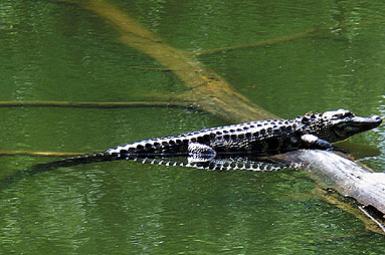
Granite Falls, North Carolina, resident Len Mendat snapped this picture of a visitor napping on a log behind his back yard on Lake Hickory, on May 8, 2009. Other sightings followed.
June 8, 2009
In North America, the warm weather is setting in, which means more people are outside seeing more visible animals, which are actively moving about.
Lake monsters? Here are some very real ones.
With all the attention on lakes – from Lake Champlain in Vermont, New York & Quebec to Okanagan Lake in British Columbia – it is time for a roundup of recent alligator sightings.
Are these sightings of crocodilians or cryptids? One big difference is that, generally, these crazy crocs are photographed clearly and often captured.
North Carolina

Granite Falls, North Carolina, resident Len Mendat snapped this picture of a visitor napping on a log behind his back yard on Lake Hickory, on May 8, 2009. Other sightings followed.
First mentioned in May 2009, a gator or two were seen in Hickory Lake, North Carolina.
Missouri
The Morgan County sheriff’s office reported that the search continues Sunday, June 7, 2009, for a missing alligator thought to be somewhere near Lake of the Ozarks, Missouri. The alligator, which is 4 to 5 feet long, was reported missing Thursday, June 4th. It was being kept as a pet and reportedly was taken from a residence. Another news report said, wait for this, the alligator “was part of a traveling show.” Deputies “warn not to touch it but call the sheriff’s office.”
Alabama
On Friday, June 5, 2009, The DeKalb County Animal Adoption Center in Alabama got quite a surprise when someone dropped off an alligator (above). Director Leslie Johnson told the local paper it’s the first exotic animal the center has received.
“A man brought it in the back of his truck,” Johnson said. “He said he found it on U.S. 11, and that’s all we know.”
Johnson said she is unsure where the 2-foot gator came from. Little River Superintendent John Bundy said it is unlikely the gator is from the area. State Lake Supervisor Jack Turner said there are gators native to central and South Alabama but not North Alabama.
“It’s a bit too far north and a bit too high in altitude for alligators in North Alabama,” Turner said. Turner said the reports of alligators in North Alabama are sporadic and there is no reason for him to believe there is a population of the reptiles in the area. Lt. Michael Casalini with the Alabama Department of Conservation and Natural Resources said if alligators were breeding in DeKalb County, there would be more sightings.
Indiana
In LaPorte County, Indiana, conservation officers were called to Pine Lake at about 8:15 a.m. Monday, June 1, 2009, to investigate the sighting of an alligator. Fishermen approximately 40 yards off shore, several hundred yards west of Huber’s boat launch, observed a 2- to 3-foot “alligator” swimming toward their fishing boat, Indiana Conservation Officer Shawn D. Brown reported.
The “alleged” alligator swam close to the fishing boat and lifted its head straight out of the water. The alligator swam around the fishermen’s boat and headed toward the shoreline. The alligator was observed two more times nearer to shore by the fishermen, Brown said.
The fishermen, shocked by what they observed, contacted the La Porte County 911 Center to report the incident. The 911 Center dispatched conservation officers to investigate the incident.
Conservation officers and Department of Natural Resources Fish & Wildlife Division personnel deployed a boat to the area where the alligator was sighted by the fishermen. Fish & Wildlife personnel utilized an electro shocking device in an attempt to raise the creature to the water’s surface, but such efforts were unsuccessful.
The DNR regulates alligators, which are not native to Indiana. Owners of alligators 5-feet or greater must have a Class 3 wild animal permit to possess them. The state DNR gets a couple of calls a year reporting alligator sightings, Brown said. Even though the reported alligator observed on Pine Lake is relatively small, the media mentioned “one would need to use caution as they would with any other animal found in the wild.”
Texas
During early May 2009, sightings of a large alligator were occurring in northern Texas, at Herman Baker Park in Sherman.
Wildlife expert Jeff Oliver, also known as Dr. Zoo, told the local media: “It’s unusual in this area. This is an extreme range for an American Alligator.”
Then on May 20, 2009, Wednesday morning, the six-foot alligator spotted at Herman Baker Park was caught (pictured above).
About Loren Coleman
Loren Coleman is one of the world’s leading cryptozoologists, some say “the” leading living cryptozoologist. Certainly, he is acknowledged as the current living American researcher and writer who has most popularized cryptozoology in the late 20th and early 21st centuries.
Starting his fieldwork and investigations in 1960, after traveling and trekking extensively in pursuit of cryptozoological mysteries, Coleman began writing to share his experiences in 1969. An honorary member of Ivan T. Sanderson’s Society for the Investigation of the Unexplained in the 1970s, Coleman has been bestowed with similar honorary memberships of the North Idaho College Cryptozoology Club in 1983, and in subsequent years, that of the British Columbia Scientific Cryptozoology Club, CryptoSafari International, and other international organizations. He was also a Life Member and Benefactor of the International Society of Cryptozoology (now-defunct).
Loren Coleman’s daily blog, as a member of the Cryptomundo Team, served as an ongoing avenue of communication for the ever-growing body of cryptozoo news from 2005 through 2013. He returned as an infrequent contributor beginning Halloween week of 2015.
Coleman is the founder in 2003, and current director of the International Cryptozoology Museum in Portland, Maine.
Filed under Breaking News, Champ/Lake Champlain Monster, Crazy Crocs, Cryptotourism, CryptoZoo News, Eyewitness Accounts, Giant Cryptid Reptiles, Lake Monsters, Megafauna, Ogopogo, Weird Animal News